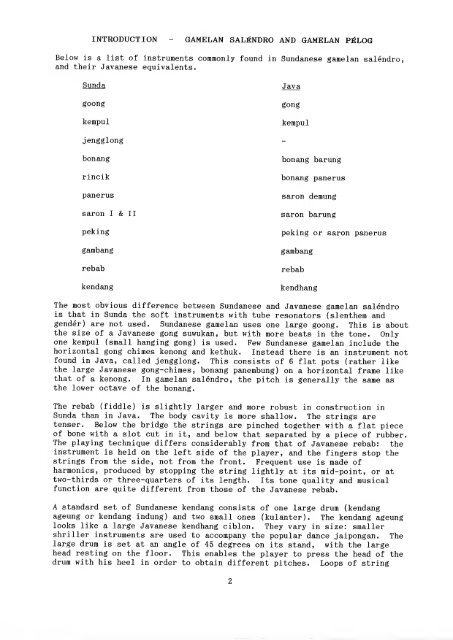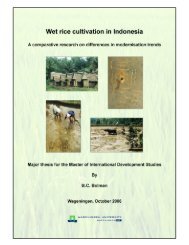Guide to Sundanese Music - Free EBooks Library
Guide to Sundanese Music - Free EBooks Library
Guide to Sundanese Music - Free EBooks Library
Create successful ePaper yourself
Turn your PDF publications into a flip-book with our unique Google optimized e-Paper software.
INTRODUCTION - GAMELAN SALlgNDRO AND GAMELAN PjgLOG<br />
Below is a list of instruments commonly found in <strong>Sundanese</strong> gamelan salendro,<br />
and their Javanese equivalents.<br />
Sunda<br />
goong<br />
kempul<br />
jengglong<br />
bonang<br />
rincik<br />
panerus<br />
saron I & II<br />
Peking<br />
gambang<br />
rebab<br />
kendang<br />
Java<br />
gong<br />
kempul<br />
bonang barung<br />
bonang panerus<br />
saron demung<br />
saron barung<br />
Peking or saron panerus<br />
gambang<br />
rebab<br />
kendhang<br />
The most obvious difference between <strong>Sundanese</strong> and Javanese gamelan salendro<br />
is that in Sunda the soft instruments with tube resona<strong>to</strong>rs (slenthem and<br />
gender) are not used. <strong>Sundanese</strong> gamelan uses one large goong. This is about<br />
the size of a Javanese gong suwukan, but with more beats in the <strong>to</strong>ne. Only<br />
one kempul (small hanging gong) is used. Few <strong>Sundanese</strong> gamelan include the<br />
horizontal gong chimes kenong and kethuk. Instead there is an instrument not<br />
found in Java, called jengglong. This consists of 6 flat pots (rather like<br />
the large Javanese gong-chimes, bonang panembung) on a horizontal frame like<br />
that of a kenong. In gamelan salendro, the pitch is generally the same as<br />
the lower octave of the bonang.<br />
The rebab (fiddle) is slightly larger and more robust in construction in<br />
Sunda than in Java. The body cavity is more shallow. The strings are<br />
tenser. Below the bridge the strings are pinched <strong>to</strong>gether with a flat piece<br />
of bone with a slot cut in it, and below that separated by a piece of rubber.<br />
The playing technique differs considerably from that of Javanese rebab: the<br />
instrument is held on the left side of the player, and the fingers s<strong>to</strong>p the<br />
strings from the side, not from the front. Frequent use is made of<br />
harmonics, produced by s<strong>to</strong>pping the string lightly at its mid-point, or at<br />
two-thirds or three-quarters of its length. Its <strong>to</strong>ne quality and musical<br />
function are quite different from those of the Javanese rebab.<br />
A standard set of <strong>Sundanese</strong> kendang consists of one large drum (kendang<br />
ageung or kendang indung) and two small ones (kulanter). The kendang ageung<br />
looks like a large Javanese kendhang ciblon. They vary in size: smaller<br />
shriller instruments are used <strong>to</strong> accompany the popular dance jaipongan. The<br />
large drum is set at an angle of 45 degrees on its stand, with the large<br />
head resting on the floor. This enables the player <strong>to</strong> press the head of the<br />
drum with his heel in order <strong>to</strong> obtain different pitches. Loops of string








